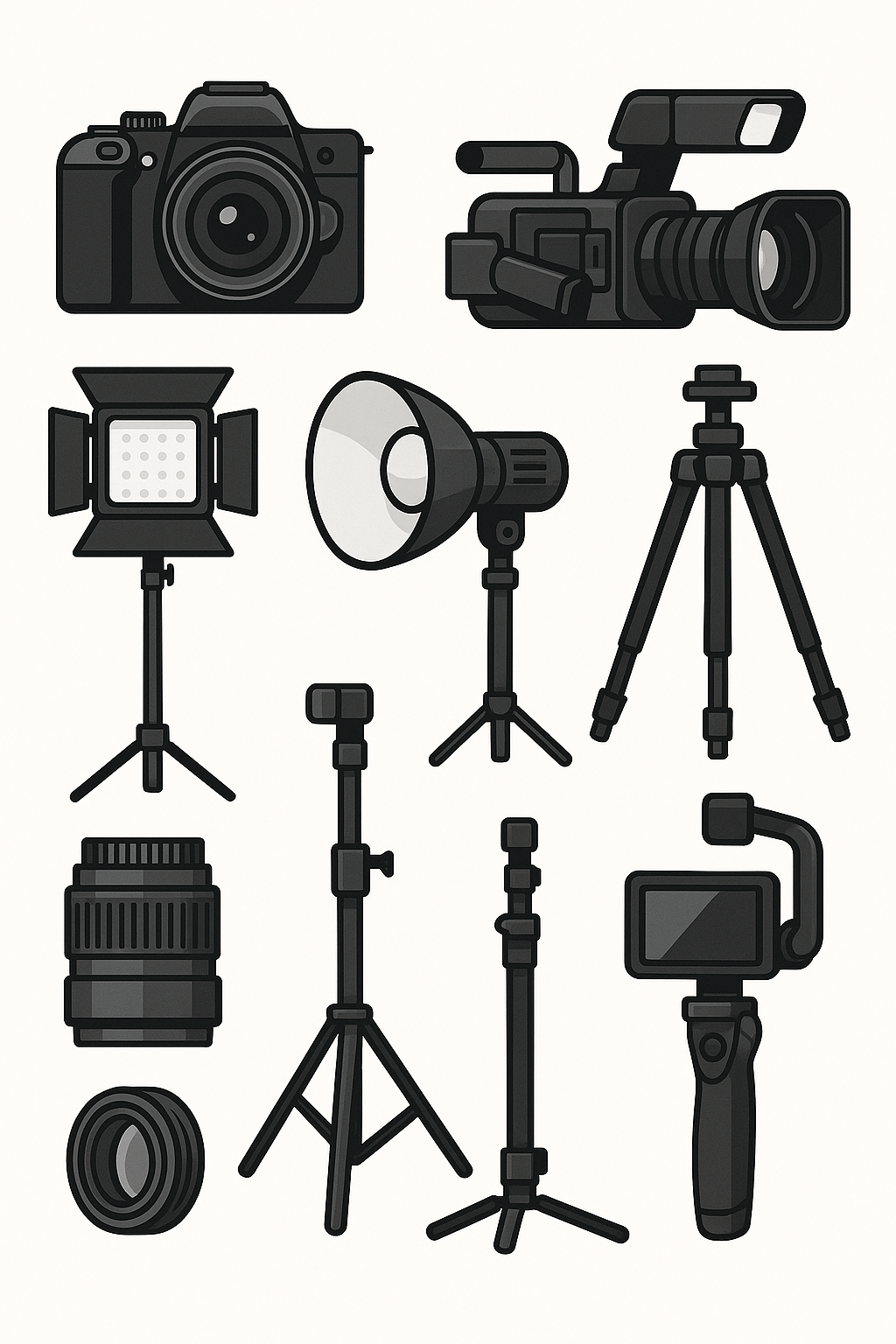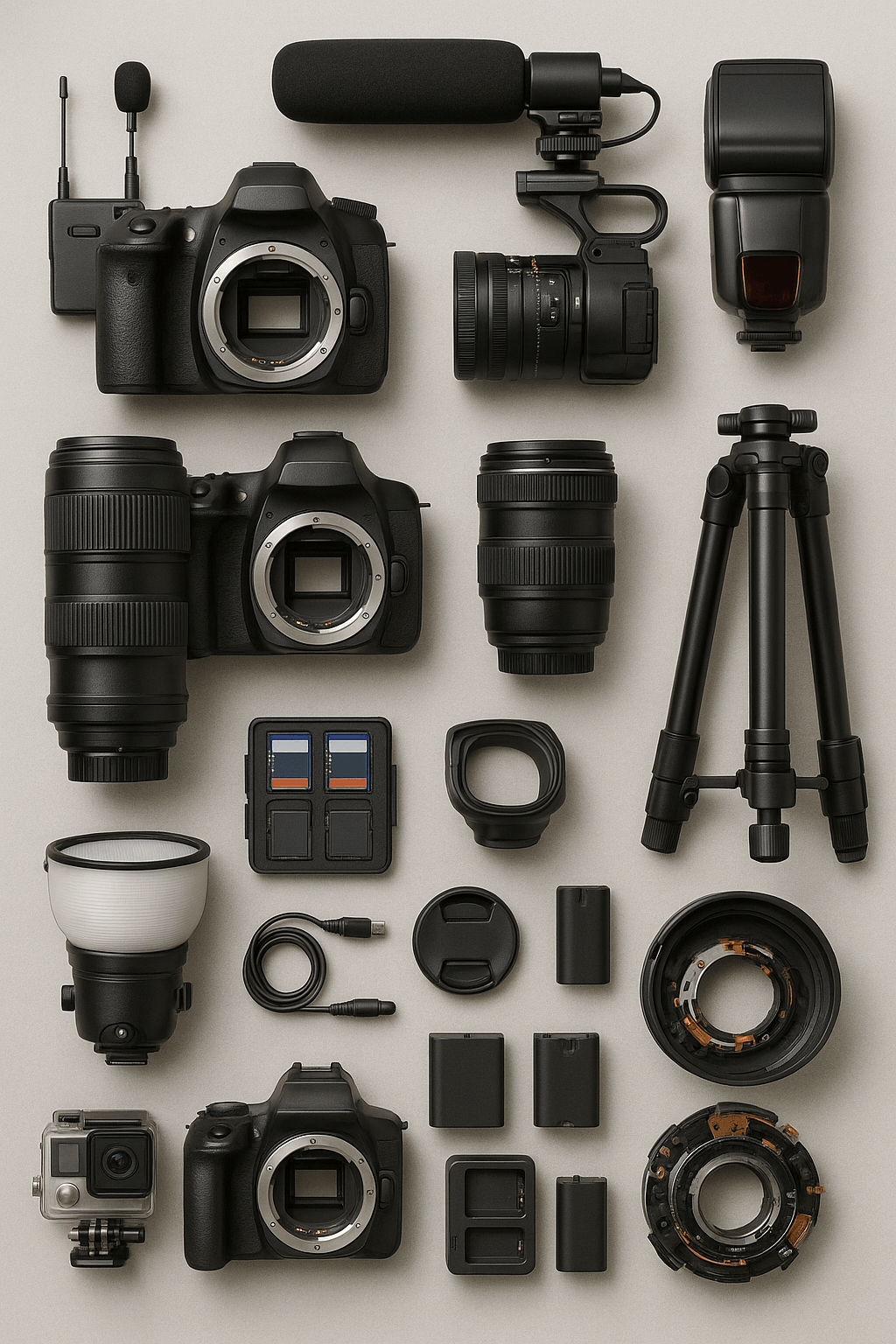Customs Clearance of Photography & Videography Equipment (HS Codes + Documents & Permits)
Customs clearance of photography and videography equipment is one of the most complex and critical stages in the supply chain of these advanced devices. It requires technical knowledge, familiarity with international regulations, and full command of customs procedures. This process entails accurate knowledge of tariff headings, compliance with international standards, obtaining mandatory permits, and proper packaging for safe transport.
Below, in addition to a full description of equipment types and their applications, we cover common HS Codes, documentation and permits, packaging tips, common risks, and best practices to accelerate clearance so importers can operate with lower cost, less risk, and higher speed.

For an estimate of time and cost for photo & video gear clearance, contact the experts at Saba Tarkhis.
Instant free consultation1) Detailed product description
- Photography and videography gear encompasses highly advanced technologies and is widely used across industries such as cinema, television, professional photography, advertising, journalism, and even home entertainment. The category includes diverse equipment, each designed for specific uses:
Digital and analog cameras: Ranging from simple consumer models to the most professional bodies used in film production. Core features include 4K-and-above video recording, advanced autofocus, and fast image processing.
Specialized lenses: Zoom, prime, macro, and telephoto lenses used for everything from portraiture to sports and macro photography. Each lens has distinct optical characteristics tailored to lighting conditions and subject distances.
Professional flashes and lighting equipment: Including studio strobes, continuous LED lights, and accessories for light control critical to improving image quality and lighting for professional film and photo sets.
Tripods and camera supports: From lightweight travel tripods to professional monopods for action filming, these tools stabilize the camera and enable higher-quality capture.
Memory cards and storage: High-capacity, high-speed media for secure storage and rapid data transfer.
2) Types & applications
- Cinema/TV production: Professional cameras, cine lenses, rigs, high-power lighting, and sound.
- Advertising studios & portrait work: Studio strobes, softboxes, backdrops, precision tripods, and prime lenses.
- Journalism & documentaries: Rugged bodies, all-round lenses, wireless microphones, and auxiliary lights.
- Home & education: Compact/mirrorless cameras, lightweight tripods, and high-speed memory cards.
3) Key clearance points
Digital cameras: HS Code 852580. Covers professional and semi-pro cameras with features like 4K video, high-speed stills, and advanced processing.
Camera lenses: HS Code 900211. Includes zoom, prime, macro, and telephoto lenses for specific photo/video applications.
Lighting equipment: HS Code 853650. Includes studio flashes, continuous LEDs, and related lighting gear used in studios.
Tripods and camera supports: HS Code 962000. Used to enhance stability and precision during capture.
These codes are globally recognized and used to set duties which may vary by origin and destination.
Beyond HS, compliance with international standards and obtaining the required permits are critical:
- CE for safety/health/environmental compliance in the EU.
- FCC for electromagnetic interference control in the U.S.
- RoHS for restricting hazardous substances in electrical/electronic equipment.
- Key tips for customs clearance of photo & video gear
Clearance is complex and specialized; following key steps ensures goods enter safely and cost-effectively. - Compliance with international standards
Ensuring equipment complies with international standards is crucial for safety, performance, and quality.
CE (Conformité Européenne): Indicates conformity with EU requirements on safety, health, and environmental protection. Mandatory for products entering from Europe; lack of CE can cause serious clearance issues.
FCC (Federal Communications Commission): U.S. standard for devices that use radio waves or may cause electromagnetic interference. Importing such equipment from the U.S. without FCC compliance is virtually impossible.
RoHS (Restriction of Hazardous Substances): EU directive limiting hazardous substances in EEE. Non-compliance can lead to re-export and heavy costs.
Obtaining necessary permits
Depending on the device, permits vary.
Permit from the Ministry of Culture & Islamic Guidance: Some professional video devices—especially those for live streaming or cinema/TV production—may require this permit to ensure cultural compliance.
Permit from the Communications Regulatory Authority: Equipment using radio frequencies (e.g., wireless mics, flash triggers) requires CRA authorization to prevent RF interference and protect national networks.
Safe and proper packaging
Given the sensitivity to environmental conditions and shock, specialized packaging is vital.
Robust materials: Choose packaging resisting humidity, impact, and temperature swings (e.g., shock-resistant foams for cameras and lenses).
Multi-layer packaging: Inner rigid boxes, protective foam, and outer cartons to shield against transit hazards.
Clear package marking: “Fragile” and “This Side Up” to minimize handling damage.
Mind currency volatility
Exchange-rate swings are a key challenge.
Financial risk management: Monitor FX and use hedging tools (for example, forwards or options) to mitigate sudden rate changes.
Pricing strategy: Set pricing that covers extra costs while remaining competitive.
4) Customs tariff / HS Code
| Item | Short description | HS Code |
|---|---|---|
| Digital cameras | Stills/video up to 4K+ | 852580 |
| Camera lenses | Zoom/prime/macro/tele | 900211 |
| Lighting equipment | Strobe/LED & light gear | 853650 |
| Tripods & supports | Tripod/monopod/heads | 962000 |
Final classification depends on technical specs/use/accessories and manufacturer documentation.
5) Special import & export conditions
Technical tests & facilities: Depending on type/use, samples may be checked for performance/safety.
Specific permits: RF equipment (wireless mics, flash triggers, etc.) requires authorization from the Communications Regulatory Authority. For certain professional/cultural uses, a permit from the Ministry of Culture & Islamic Guidance may be required.
Taxes & duties: VAT is charged on customs value + import duty. Duties vary by tariff line and origin.
Need precise HS classification, order registration, and permits? Our team handles the entire case end-to-end.
Request a proforma quote6) Iran market
Importing countries: Iran imports primarily from Japan, China, and the UAE. Neighboring Turkey and the UAE are also major importers in the region.
7) Trade volume
Imports of photo & video equipment into Iran have grown in recent years as demand for high-quality visual content has surged. Exchange-rate volatility and regulatory changes, however, can affect this trend.
8) Global market
- Global exporters: Japan, Germany, China, South Korea, and the U.S.; home to Canon, Nikon, Sony, Fujifilm, and Zeiss.
- Major importers: Emerging Asian markets, the Middle East, and African countries, driven by growing digital media and infrastructure needs.
9) Documents required for clearance
- To clear photo & video gear, multiple documents are essential, each playing a crucial role:
1. Commercial Invoice
Complete details (quantity, unit price, total price, terms of sale). Must be accurate to avoid tariff/tax issues.
2. Packing List
Details of packing: number of packages, weight, dimensions, and contents—enables proper inspection.
3. Certificate of Origin
Issued by the chamber of commerce in the exporting country; used for customs tariffs and any preferential schemes.
4. Bill of Lading or Air Waybill
Transport document and receipt indicating shipper/consignee, goods, and carriage terms; proves arrival for clearance.
5. Specific Permits
E.g., Ministry of Culture & Islamic Guidance for certain pro video gear/cultural products. CRA permit for RF equipment.
6. Customs Declaration
Filed by the importer; includes values, origin, and HS Codes basis for duties and taxes.
7. Insurance Certificate
Shows the shipment is insured for transit risks.
8. Inspection Certificate
Sometimes required from an independent inspector to confirm conformity with order/specs.
9. Proforma Invoice
Pre-invoice used for permits and foreign-exchange allocation.
10. Banking Documents
Evidence of payment: bank transfers, SWIFT, L/C documentation.
11. Trade/Import License (Business Card)
Authorizes the company to import/export; must be valid.
12. Tax IBAN/registration
Tax-related identifiers required by the authorities for clearance.
13. Standard/Conformity Certificates (if required)
National/international proof of compliance where applicable.
14. Entry Permit
Issued by competent authorities (e.g., Ministry of Industry, Mine & Trade) allowing import.
Tax note: VAT is calculated on customs value plus import duty. Duty depends on HS and origin.

Frequently asked questions
What are common HS Codes for photo & video gear?
Per your data: digital cameras 852580, lenses 900211, lighting 853650, and tripods 962000. Final lines depend on technical specs.
What documents are required for clearance?
Invoice, Packing List, Certificate of Origin, B/L or AWB, Customs Declaration, Insurance, and if needed permits from Culture Ministry/CRA and standards certificates.
How can I reduce damage risk to equipment?
Use multi-layer packaging with shock-resistant foam, control humidity/temperature, mark as Fragile/This Side Up, and select suitable mode (air/sea) with adequate insurance.
Are CE/FCC/RoHS standards mandatory?
Often yes for electronic items; depending on origin and application, customs or relevant authorities may require conformity documentation.
Premium customs services by Saba Brokerage
Leveraging extensive knowledge and experience in customs clearance, Saba Brokerage delivers specialized services for importers of photography and videography equipment from first consultation to final delivery. Key services include:
Specialized consulting: Our seasoned team advises on tariffs, international standards, and required permits across all clearance stages.
Customs follow-up: We proactively track procedures to expedite clearance, relying on experience and strong relationships to keep processes smooth.
Obtaining permits: In close coordination with relevant bodies, we secure the necessary authorizations for importing imaging equipment quickly and efficiently.
Safe packaging & transport: With deep insight into packaging/transport needs for delicate gear, we ensure arrival without damage.
Cost management: We optimize total landed cost tariffs, taxes, and incidentals to reduce expenses and raise efficiency.
These services ensure a professional, fast, and cost-effective clearance journey so you can import essential equipment with confidence.
.png)
